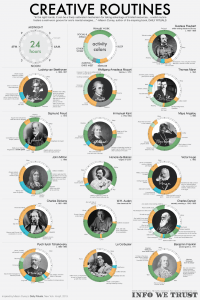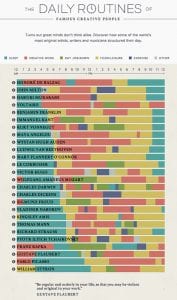When we’re talking about writing, we often suggest that a regular routine is best. That routine doesn’t, however, have to be one that fits into a neat 9-5 day. As the following examples show, the routines adopted by some of history’s most creative people, vary widely.
Some are more 9-5… Maya Angelou worked regularly from 7 a.m. to about 3 p.m., and then took a break, doing about a half hour’s more work at 7.30 p.m.
Some, though, are very different. Honoré de Balzac, for example, did most of his creative work between 1 a.m. and 8 a.m., had an hour’s snooze, and then worked again from 9 a.m. until about half past three in the afternoon.
Charles Dickens worked only in the morning, spending the afternoon tramping for miles around London and in the countryside soaking up the atmosphere that he then wrote into his prose.
Voltaire, on the other hand, appears to have done little else but work, sleeping only 4 hours a night, and pausing only briefly to eat.
And in terms of working environment, they differ too. While Dickens wrote in absolute silence in his study, Angelou wrote only in hotel rooms. John Milton was blind by the age of 40, and so dictated his work. W. H. Auden (and this is one that, even as much as we encourage productivity and focus, we probably wouldn’t recommend) took a daily dose of Benzedrine to aid his concentration.
What’s your routine? And your own working practice?
(note – Due to copyright restrictions, these images are screengrabs. But various versions of these have proliferated online, so you’ll find alternative, or better quality versions by simply searching for ‘Daily Routines of Creative People’).



